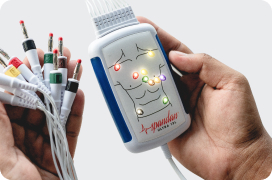
Author:- Mr. Ritesh Sharma
When it comes to monitoring health, understanding vital signs is crucial. One such vital sign is the pulse rate, commonly measured in beats per minute (BPM). In medical contexts, PRBPM means Pulse Rate Beats Per Minute, a critical indicator of a person’s heart health and overall well-being. This blog will explore what PRBPM means, its significance in medical assessments, and how it is measured and interpreted.
What PRBPM Means
PRBPM stands for Pulse Rate Beats Per Minute. This term is used to quantify the number of times a person’s heart beats in one minute. The pulse rate is a vital sign that provides insight into the heart’s functioning and the body’s circulatory health. By measuring the PRBPM, healthcare professionals can assess whether the heart is working efficiently and identify potential health issues.
The Importance of PRBPM in Medical Assessments
- Indicator of Heart Health: PRBPM is a primary indicator of heart health. A normal resting pulse rate for adults typically ranges from 60 to 100 beats per minute. Deviations from this range can signal various health conditions. For instance, a persistently high pulse rate (tachycardia) can indicate stress, fever, or heart problems, while a low pulse rate (bradycardia) might suggest issues such as heart block or high physical fitness levels.
- Diagnostic Tool: In clinical settings, measuring the PRBPM is a routine part of physical examinations. It helps in diagnosing conditions like arrhythmias, where the heart beats irregularly, and in monitoring patients with cardiovascular diseases. Sudden changes in PRBPM can alert healthcare providers to acute medical issues needing immediate attention.
- Monitoring Fitness and Stress Levels: For athletes and fitness enthusiasts, PRBPM is an essential metric. It helps in tracking cardiovascular fitness levels and the effectiveness of training regimens. Additionally, PRBPM can reflect stress levels, with elevated pulse rates often indicating increased stress or anxiety.
How PRBPM is Measured
Measuring PRBPM is straightforward and can be done manually or with electronic devices:
- Manual Measurement: To measure the pulse rate manually, locate the radial artery on the wrist or the carotid artery on the neck. Using the index and middle fingers, gently press on the artery and count the number of beats for 30 seconds, then multiply by two to get the PRBPM. This method is simple but requires some practice to ensure accuracy.
- Electronic Devices: Modern technology has made measuring PRBPM easier and more accurate. Devices such as digital blood pressure monitors, fitness trackers, and smartwatches can automatically measure and display pulse rates. These devices often come with additional features like tracking heart rate trends over time and alerting users to abnormal readings.
Interpreting PRBPM Readings
Understanding what different PRBPM readings mean is crucial for proper health management:
- Normal Pulse Rate: For most adults, a normal resting pulse rate ranges from 60 to 100 beats per minute. Athletes or highly active individuals might have lower resting pulse rates, sometimes as low as 40 BPM, due to their enhanced cardiovascular efficiency.
- Tachycardia: A resting pulse rate above 100 BPM is considered tachycardia. Causes can range from physical exertion, fever, and dehydration to more severe conditions like heart disease, hyperthyroidism, or infections.
- Bradycardia: A resting pulse rate below 60 BPM is termed bradycardia. While it can be normal for well-trained athletes, in others, it might indicate conditions such as hypothyroidism, electrolyte imbalances, or heart block. Symptoms like dizziness, fatigue, and fainting associated with bradycardia warrant medical evaluation.
- Irregular Pulse: An irregular PRBPM may indicate cardiac arrhythmias of different arrhythmia classifications, which can range from benign to life-threatening. Conditions such as atrial fibrillation require medical intervention and ongoing monitoring.
Factors Affecting PRBPM
Several factors can influence PRBPM, making it essential to consider context when interpreting readings:
- Age: Children typically have higher pulse rates than adults. As people age, their resting pulse rate generally decreases.
- Fitness Level: Regular physical activity can lower the resting PRBPM by improving cardiovascular efficiency.
- Medications: Certain medications, such as beta-blockers, can lower the pulse rate, while others, like stimulants, can increase it.
- Emotional State: Stress, anxiety, and excitement can cause temporary increases in PRBPM.
- Health Conditions: Illnesses, especially those affecting the cardiovascular and respiratory systems, can significantly impact PRBPM.
Monitoring PRBPM for Better Health
Regular monitoring of PRBPM can provide valuable insights into one’s health and help detect early signs of potential health issues. Here are some tips for effective monitoring:
- Consistency: Measure your pulse rate at the same time each day, preferably when you are relaxed and rested, to ensure consistency.
- Record Keeping: Keep a log of your PRBPM readings to track trends and identify any significant changes.
- Seek Medical Advice: If you notice persistent deviations from your normal PRBPM range or experience symptoms like dizziness, shortness of breath, or chest pain, consult a healthcare professional.
In the field of healthcare, understanding what PRBPM means is fundamental to assessing and monitoring heart health. By keeping track of pulse rate beats per minute, individuals and healthcare providers can gain valuable insights into cardiovascular function and overall well-being. Regular monitoring, coupled with a holistic understanding of factors affecting PRBPM, can lead to better health outcomes and timely medical interventions. Remember, your pulse rate is more than just a number; it’s a window into your heart’s health.





